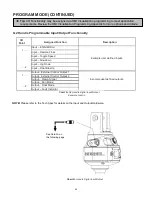
WIRE ROPE INSPECTION
1. Frequent Inspection
The operator or other designated person should visually inspect all ropes at the
start of each shift. These visual observations should be concerned with
discovering gross damage, such as listed below, which may be an immediate
hazard:
• distortion of the rope such as kinking, crushing, unstranding, birdcaging, main strand
displacement, or core protrusion;
• general corrosion;
• broken or cut strands;
• number, distribution, and type of visible broken wires (see next section on rope
replacement).
When such damage is discovered, the rope shall either be removed from
service or given an inspection as detailed in the next section.
2. Periodic Inspection
The inspection frequency shall be determined by a qualified person and shall
be based on such factors as expected rope life as determined by experience
on the particular installation or similar installations; severity of environment;
percentage of capacity lifts; frequency rates of operation; and exposure to
shock loads. Inspections need not be at equal calendar intervals and should
be more frequent as the rope approaches the end of its useful life.
A designated person shall perform periodic inspections. This inspection shall
cover the entire length of rope. The individual outer wires in the strands of the
rope shall be visible to this person during the inspection. Any deterioration
resulting in appreciable loss of original strength, such as described below, shall
be noted, and determination shall be made as to whether further use of the
rope would constitute a hazard:
• Points listed in previous section on
Frequent Inspection
.
• Reduction of rope diameter below nominal diameter due to loss of core
support, internal or external corrosion, or wear of outside wires.
• Severely corroded or broken wires at end connections.
• Severely corroded, cracked, bent, worn, or improperly applied end connections.
Special care should be taken when inspecting sections of rapid deterioration, such
as the following:
• Sections in contact with saddles, equalizer sheaves, or other sheaves
where rope travel is limited.
• Sections of rope at or near terminal ends where corroded or broken wires may
protrude.
• Sections subject to reverse bends.
• Sections of ropes that are normally hidden during visual inspection, such as
parts passing over sheaves.
51
Содержание G-Force iQ2 1320 lb
Страница 44: ...PROGRAM MODE CONTINUED 44...
Страница 46: ...PROGRAM MODE CONTINUED Diagram K Handle IO Detail Pendant Model 46...
Страница 85: ...Figure 9 VNC Viewer App 85...
















































